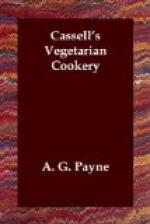In making soups, as a rule, the four vegetables essential are, onion, celery, carrot and turnip; and we place them in their order of merit. In making vegetarian soup it is very important that we should learn how to blend these without making any one flavour too predominant. This can only be learnt by experience. If we have too much onion the soup tastes rank; too much celery will make it bitter; too much carrot often renders the soup sweet; and the turnip overpowers every other flavour. Again, these vegetables vary so much in strength that were we to peel and weigh them the result would not be uniform, in addition to the fact that not one cook in a thousand would take the trouble to do it. Perhaps the most dangerous vegetable with which we have to deal is turnip. These vary so very much in strength that sometimes even one slice of turnip will be found too strong. In flavouring soups with these vegetables, the first care should be to see that they are thoroughly cleansed. In using celery, too much of the green part should be avoided if you wish to make first-rate soup. In using the onions, if they are old and strong, the core can be removed. In using carrot, if you are going to have any soup where vegetables will be cut up and served in the soup, you should always peel off the outside red part of the carrot and reserve it for this purpose, and only use the inside or yellow part for flavouring purposes if is going to be thrown away or to lose its identity by being rubbed through a wire sieve with other vegetables. With regard to turnip, we can only add one word of caution—not too much. We may here mention, before leaving the subject of ingredients, that leeks and garlic are a substitute for onion, and can also be used in conjunction with it.
As a rule, in vegetarian cookery clear soups are rare, and, of course, from an economical point of view, they are not to be compared with thick soups. Some persons, in making stock, recommend what is termed bran tea. Half a pint of bran is boiled in about three pints of water, and a certain amount of nutriment can be extracted from the bran, which also imparts colour.
For the purpose of colouring clear soups, however, there is nothing in the world to compare with what French cooks call caramel. Caramel is really burnt sugar. There is a considerable art in preparing it, as it is necessary that it should impart colour, and colour only. When prepared in the rough-and-ready manner of burning sugar in a spoon, as is too often practised in English kitchens, this desideratum is never attained, as you are bound to impart sweetness in addition to a burnt flavour. The simplest and by far the most economical method of using caramel is to buy it ready-made. It is sold by all grocers under the name of Parisian Essence. A small bottle, costing about eightpence, will last a year, and saves an infinite loss of time, trouble, and temper.
By far the most economical soups are the thick, where all the ingredients can be rubbed through a wire sieve. Thick soups can be divided into two classes—ordinary brown soup, and white soup. The ordinary brown is the most economical, as in white soups milk is essential, and if the soup is wished to be very good it is necessary to add a little cream.




